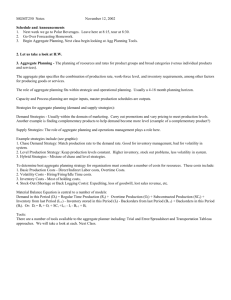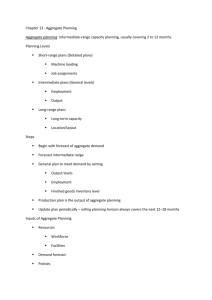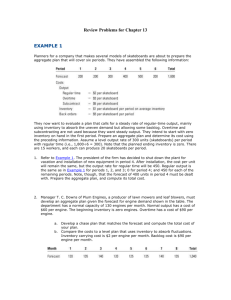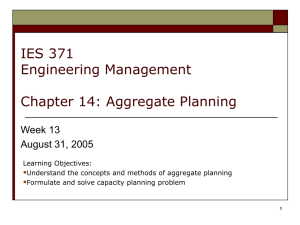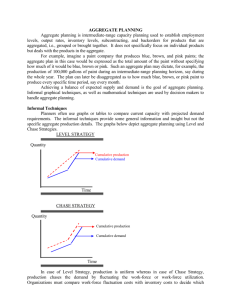Aggregate Planning Strategies: Level vs. Chase
advertisement
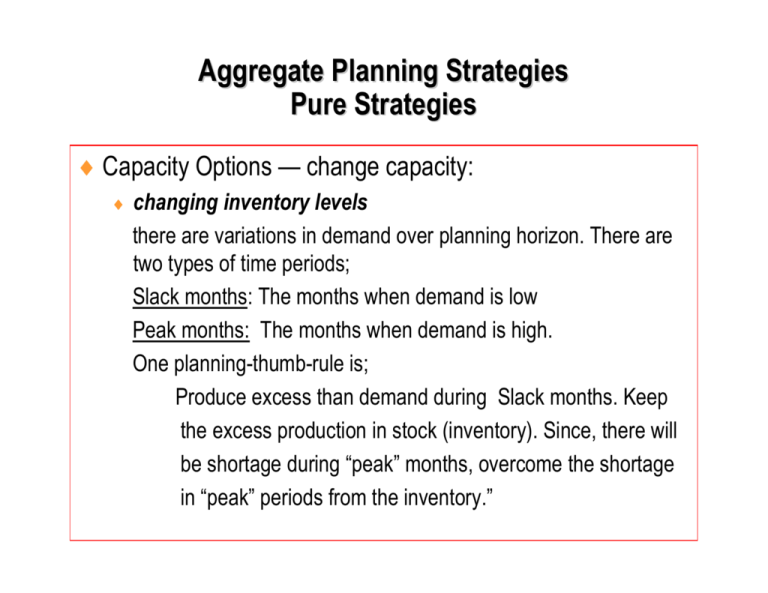
Aggregate Planning Strategies Pure Strategies ♦ Capacity Options — change capacity: ♦ changing inventory levels there are variations in demand over planning horizon. There are two types of time periods; Slack months: The months when demand is low Peak months: The months when demand is high. One planning-thumb-rule is; Produce excess than demand during Slack months. Keep the excess production in stock (inventory). Since, there will be shortage during “peak” months, overcome the shortage in “peak” periods from the inventory.” Aggregate Planning Strategies Pure Strategies ♦ Capacity Options — change capacity: ♦ varying work force size by hiring or layoffs The utility of work-force increases or decreases with an organization’s work load. During “peak” period, organization requires more and more work force. However, the large pool of work force remains under-utilized in “slack” period. In order to keep tight control over expenses, organizations should employ matching number of workers in “peak” as well as in “slack” periods. This implies that large work force should be employed (“hired”) in peak period and, excess work force should be laid-off (“fired”) in “slack period”. Aggregate Planning Strategies Pure Strategies ♦ Capacity Options — change capacity: ♦ varying production capacity through overtime or idle time If frequent hiring/firing is not feasible, then organizations will have a constant pool of work force of adequate size. In “slack periods”, some of the work force will remain under-utilized. However, some portion of the work force will be engaged in over time as well during “peak” period. This strategy is far better than frequent hiring and firing of the work force. Aggregate Planning Strategies Pure Strategies ♦ Capacity Options — change capacity: ♦ ♦ Subcontracting If some portion of the work order is technically complex and, requires special expertise. Also, this work is not of repetitive nature, then organization can award the work to some 3rd party (subcontracting) using part-time workers If organization’s regular work force is too much occupied with work loads, some portion of work may be assigned to part-time workers. Aggregate Planning Strategies Pure Strategies ♦ Demand Options — change demand: influencing demand demand rises and goes down because of buying trend of the consumer. Offer special discounts during low-demand periods so as to increase sales. ♦ backordering during high demand periods since capacity is limited and all the demand cannot be met ontime, get permission from customer to deliver the products at a later time; e.g., meeting January demand by producing in March (Late delivery) ♦ counterseasonal product mixing some organizations are engaged in producing more than two products. One product has high demand in winter , and, the other product has demand in summer. ♦ Aggregate Scheduling Options - Advantages and Disadvantages Option Advantage Disadvantage Some Comments Changing Changes in Inventory Applies mainly inventory levels human resources are gradual, not holding costs; Shortages may to production, not service, abrupt result in lost operations production changes sales Avoids use of other alternatives Hiring, layoff, and training Used where size of labor pool is costs large Varying workforce size by hiring or layoffs Advantages/Disadvantages - Continued Option Advantage Disadvantage Some Comments Varying Matches seasonal Overtime Allows production rates through overtime or idle time fluctuations without hiring/training premiums, tired workers, may not meet demand flexibility within the aggregate plan Permits flexibility and Loss of quality control; reduced Applies mainly in production smoothing of the firm's output profits; loss of future business settings costs Subcontracting Advantages/Disadvantages - Continued Option Advantage Disadvantage Some Comments Using part-time workers Less costly and more flexible than full-time workers Good for unskilled jobs in areas with large temporary labor pools Influencing demand Tries to use excess capacity. Discounts draw new customers. High turnover/training costs; quality suffers; scheduling difficult Uncertainty in demand. Hard to match demand to supply exactly. Creates marketing ideas. Overbooking used in some businesses. Advantage/Disadvantage - Continued Option Advantage Disadvantage Some Comments Back ordering during highdemand periods May avoid overtime. Keeps capacity constant Customer must be willing to wait, but goodwill is lost. Many companies backorder. Counterseasonal products and service mixing Fully utilizes resources; allows stable workforce. May require skills or equipment outside a firm's areas of expertise. Risky finding products or services with opposite demand patterns. Aggregate Planning Strategies Level Strategy Chase Strategy Production rate is constant Production equals demand The Extremes Aggregate Planning Strategies ♦ Mixed strategy ♦ Combines 2 or more aggregate scheduling options ♦ uses alternatives mixing inventory, back order, capacity change, work force change, etc ♦ Level scheduling strategy Produce same amount of products every day ♦ Keep work force level constant ♦ Vary non-work force capacity or demand options ♦ Often results in lowest production costs ♦
